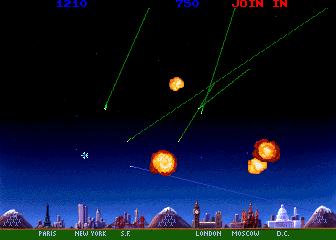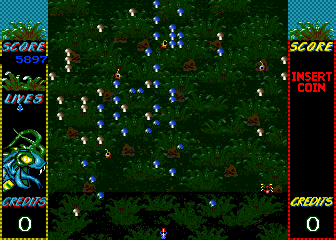 Atari’s
waning years almost turned them into Panasonic’s kid sister. During
those last few attempts at recapturing lost glory (and dollars) Atari was
occasionally, “just slightly ahead of [their] time.” Unfortunately,
Atari always managed to be slightly ahead of their time at slightly the
wrong time, or wrong place. Remember the 64-bit Jaguar, the first 64-bit (“do
the math!”) home gaming console? Remember the Lynx, the first color
portable game unit? Remember “Arcade Classics,” among the first
coin-ops that gave gamers a healthy dose of nostalgia? Remember the way
all of these gaming firsts fell by the wayside due to lukewarm response
from a public that was just slightly not ready to accept them?
Atari’s
waning years almost turned them into Panasonic’s kid sister. During
those last few attempts at recapturing lost glory (and dollars) Atari was
occasionally, “just slightly ahead of [their] time.” Unfortunately,
Atari always managed to be slightly ahead of their time at slightly the
wrong time, or wrong place. Remember the 64-bit Jaguar, the first 64-bit (“do
the math!”) home gaming console? Remember the Lynx, the first color
portable game unit? Remember “Arcade Classics,” among the first
coin-ops that gave gamers a healthy dose of nostalgia? Remember the way
all of these gaming firsts fell by the wayside due to lukewarm response
from a public that was just slightly not ready to accept them?
Even if you do remember the Jag and the Lynx, you might not remember Arcade Classics. (By this time, Atari Home and Coin divisions were two separate companies, but anyway…) Don’t worry though, you’re not losing your mind. Arcade Classics, planned for release in 1992 to celebrate twenty years of Atari, never made it to the arcades, despite the fact that it was (almost?) completed.
While not entirely “Super,” Super Centipede could have just as easily been given the Roman numeral treatment that was given to Missile Command. Even then, the “II” is more like the “2” at the end of funny movies like “Evil Dead 2” or scary movies like “Home Alone 2.” Both films are admitted remakes of the originals with a couple of extra bucks. Missile Command II and Super Centipede are the Evil Dead 2 and Home Alone 2 of the original games.
Like that timeless (and dopey) wedding cliché, Super Centipede contains something old, (Centipede’s main elements) something new, (two-player simultaneous play – very cool!, power-ups) something borrowed (Mosquitoes, DDT from Millipede) and something blue (the “left” player is “blue, the right player is “red”). The cartoony revised graphics (thankfully) don’t go too overboard with crazy new 3D rendered bugs – the entire cast is immediately recognizable. A forest backdrop is included, and as with Millipede, the bottom portion of the screen (where the blaster can move about) is marked by a slight offset of the foliage.
Perhaps the most welcome graphic embellishment in the new model is a snarling centipede that sits on either side of the screen. When a player earns an extra life, the centipede springs into action and announces “extra life!” in a well done piece of animation. The centipede also wakes up to announce, “nice score!” if the player makes it into the high score table at the end of the game. Other vocal stylings include a countdown (5, 4, 3…) during the last few seconds that a powerup (invincibility, double speed shots) is effective.
 Missile
Command II fares even better in the graphic-overhaul department. Here,
the original game’s nondescript cities are replaced by nicely rendered
drawings of Paris, New York, San Francisco, London, Moscow and Washington
DC. The explosions, mushroom clouds, UFOs, planes and mountain silos have
been given a more realistic facelift as well (think Blasteroids
graphics). MCII also includes bonus rounds where the player must launch
missiles from the three silos (without using the crosshair) to destroy
flying saucers that attack “Air-Sea Battle” style. Finally, the
player squares off against a renegade mothership that may or may not have
escaped from the scrapped Xevious II game.
Missile
Command II fares even better in the graphic-overhaul department. Here,
the original game’s nondescript cities are replaced by nicely rendered
drawings of Paris, New York, San Francisco, London, Moscow and Washington
DC. The explosions, mushroom clouds, UFOs, planes and mountain silos have
been given a more realistic facelift as well (think Blasteroids
graphics). MCII also includes bonus rounds where the player must launch
missiles from the three silos (without using the crosshair) to destroy
flying saucers that attack “Air-Sea Battle” style. Finally, the
player squares off against a renegade mothership that may or may not have
escaped from the scrapped Xevious II game.
The two-player simultaneous play option is also present in Missile Command II, but it doesn’t match the fun of doubles Centipede. In MCII, each player winds up with only half of the missiles in each of the three silos. Missile Command II’s announcer exclaims, “bonus points” and “bonus city” when appropriate, but the Centipede voice that congratulates a player’s “nice score” also congratulates the gamer that earned a place on the Missile Command list. Problem is, the voice is very out of place -- perhaps it was scheduled to be replaced by the MC announcer if the game had gone into production. My only real gripe about MCII is that the apocalyptic “THE END” ending is conspicuously absent. Leaving it out is like playing Asteroids without… well, asteroids!
The early bird doesn’t always get the worm, and because it was just slightly ahead of its time, Arcade Classics never saw the light of day. A few years later, Namco would repackage some of their greatest hits for the arcade, including the original games alongside new “arrangements.” Namco happened to be in the right place in the right time (they’re nigh invincible it seems), and their offering of three classic hits in one machine proved successful. Perhaps if Atari had tweaked their Classics machine just a little bit more and released it just a little bit later, after the “classic” gaming scene had expanded ever so slightly, it would have been a hit. Timing can be everything. As it stands, Classics is an interesting game, but only just slightly ahead of what made the original versions so much fun.
NOTE: Ironically, while the arcade game went unreleased, Arcade Classics, once again featuring (almost) updated versions of Centipede and Missile Command (and Pong), made its way to the Sega Genesis in 1996. DP’s very own Clint Dyer was the “Product Specialist” for the game! This Genesis cart is really just a repackaging of a truly odd hybrid of the original arcade games and subsequent 2600/5200 versions and probably shouldn’t be confused with this unreleased arcade game.
